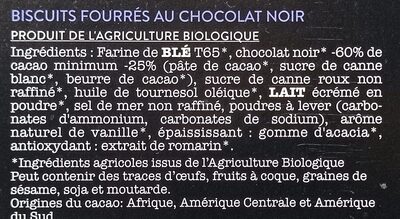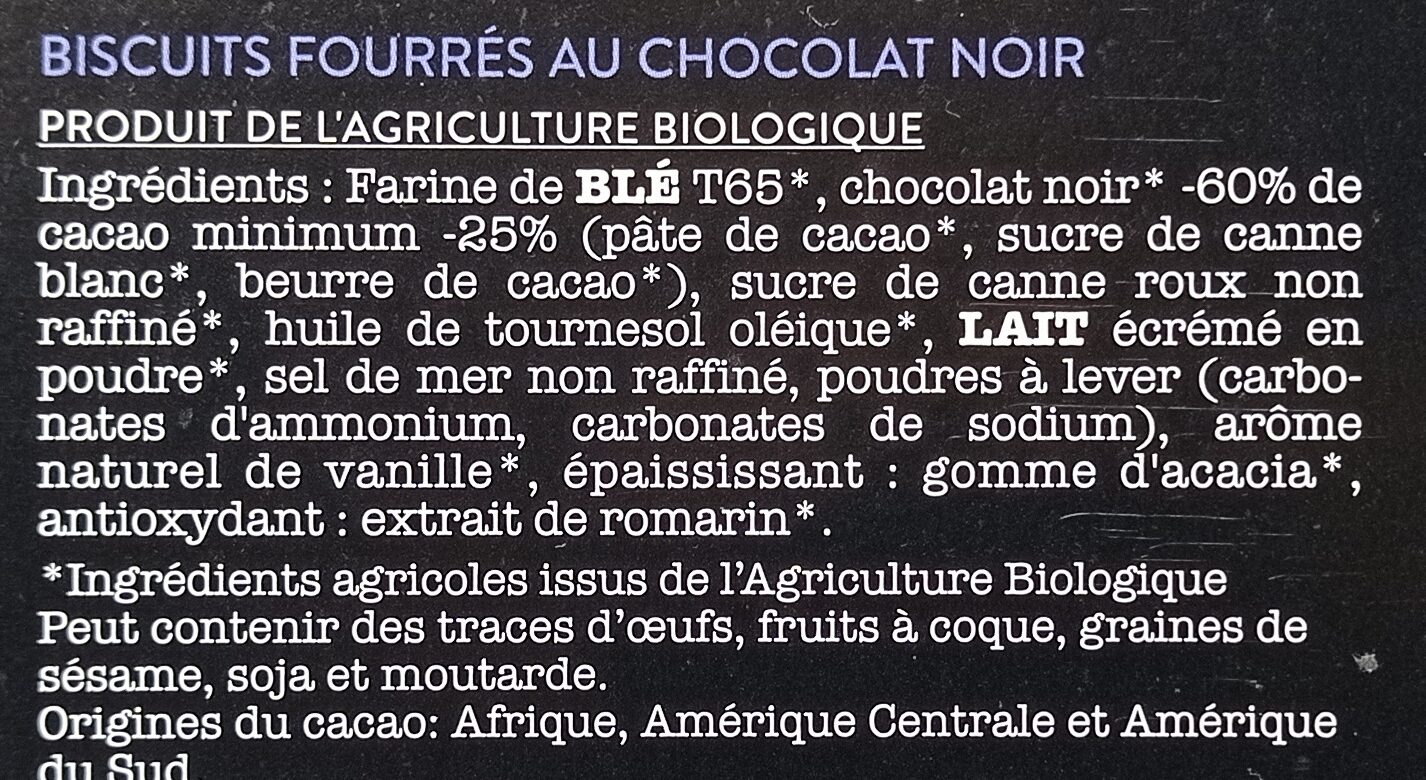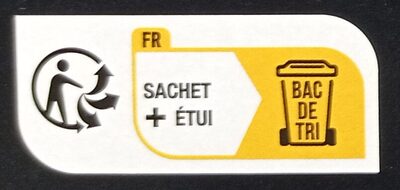Help us make food transparency the norm!
As a non-profit organization, we depend on your donations to continue informing consumers around the world about what they eat.
The food revolution starts with you!
Biscuit Fourré chocolat - La Vie Claire - 225 g
Biscuit Fourré chocolat - La Vie Claire - 225 g
This product page is not complete. You can help to complete it by editing it and adding more data from the photos we have, or by taking more photos using the app for Android or iPhone/iPad. Thank you!
×
Barcode: 3266191085524 (EAN / EAN-13)
Quantity: 225 g
Brands: La Vie Claire
Categories: Snacks, Sweet snacks, Biscuits and cakes, Biscuits, Chocolate biscuits, Filled biscuits
Labels, certifications, awards:
Organic, EU Organic, Non-EU Agriculture, EU Agriculture, EU/non-EU Agriculture, FR-BIO-01, Made in France, No palm oil, AB Agriculture Biologique

Manufacturing or processing places: France
Stores: La Vie Claire
Countries where sold: France
Matching with your preferences
Health
Ingredients
-
18 ingredients
French: Farine de BLÉ T65*, chocolat noir* - 60% de cacao minimum - 25% (pâte de cacao*, sucre de canne blanc*, beurre de cacao*), sucre de canne roux non raffiné, huile de tournesol oléique*, LAIT écrémé en poudre*, sel de mer non raffiné, poudres à lever (carbonates d'ammonium, carbonates de sodium), arôme naturel de vanille*, épaississant: gomme d'acacia*, antioxydant: extrait de romarin*. *Ingrédients agricoles issus de l'Agriculture Biologique Peut contenir des traces d'oeufs, fruits à coque, graines de sésame, soja et moutarde.Allergens: Eggs, Gluten, MilkTraces: Mustard, Nuts, Sesame seeds, Soybeans
Food processing
-
Ultra processed foods
Elements that indicate the product is in the 4 - Ultra processed food and drink products group:
- Additive: E414 - Acacia gum
- Ingredient: Flavouring
- Ingredient: Thickener
Food products are classified into 4 groups according to their degree of processing:
- Unprocessed or minimally processed foods
- Processed culinary ingredients
- Processed foods
- Ultra processed foods
The determination of the group is based on the category of the product and on the ingredients it contains.
Additives
-
E414 - Acacia gum
Gum arabic: Gum arabic, also known as acacia gum, arabic gum, gum acacia, acacia, Senegal gum and Indian gum, and by other names, is a natural gum consisting of the hardened sap of various species of the acacia tree. Originally, gum arabic was collected from Acacia nilotica which was called the "gum arabic tree"; in the present day, gum arabic is collected from acacia species, predominantly Acacia senegal and Vachellia -Acacia- seyal; the term "gum arabic" does not indicate a particular botanical source. In a few cases so‐called "gum arabic" may not even have been collected from Acacia species, but may originate from Combretum, Albizia or some other genus. Producers harvest the gum commercially from wild trees, mostly in Sudan -80%- and throughout the Sahel, from Senegal to Somalia—though it is historically cultivated in Arabia and West Asia. Gum arabic is a complex mixture of glycoproteins and polysaccharides. It is the original source of the sugars arabinose and ribose, both of which were first discovered and isolated from it, and are named after it. Gum arabic is soluble in water. It is edible, and used primarily in the food industry as a stabilizer, with EU E number E414. Gum arabic is a key ingredient in traditional lithography and is used in printing, paint production, glue, cosmetics and various industrial applications, including viscosity control in inks and in textile industries, though less expensive materials compete with it for many of these roles. While gum arabic is now produced throughout the African Sahel, it is still harvested and used in the Middle East.Source: Wikipedia
-
E500 - Sodium carbonates
Sodium carbonates (E500) are compounds commonly used in food preparation as leavening agents, helping baked goods rise by releasing carbon dioxide when they interact with acids.
Often found in baking soda, they regulate the pH of food, preventing it from becoming too acidic or too alkaline. In the culinary world, sodium carbonates can also enhance the texture and structure of foods, such as noodles, by modifying the gluten network.
Generally recognized as safe, sodium carbonates are non-toxic when consumed in typical amounts found in food.
-
E503 - Ammonium carbonates
Ammonium carbonate: Ammonium carbonate is a salt with the chemical formula -NH4-2CO3. Since it readily degrades to gaseous ammonia and carbon dioxide upon heating, it is used as a leavening agent and also as smelling salt. It is also known as baker's ammonia and was a predecessor to the more modern leavening agents baking soda and baking powder. It is a component of what was formerly known as sal volatile and salt of hartshorn.Source: Wikipedia
Ingredients analysis
-
Palm oil free
No ingredients containing palm oil detected
-
Non-vegan
Non-vegan ingredients: Skimmed milk powder
-
Vegetarian
No non-vegetarian ingredients detected
-
Details of the analysis of the ingredients
fr: Farine de BLÉ T65, chocolat noir, cacao minimum 60%, pâte de cacao, sucre de canne blanc, beurre de cacao, sucre de canne roux non raffiné, huile de tournesol oléique, LAIT écrémé en poudre, sel de mer non raffiné, poudres à lever (carbonates d'ammonium, carbonates de sodium), arôme naturel de vanille, épaississant (gomme d'acacia), antioxydant (extrait de romarin)- Farine de BLÉ T65 -> fr:farine-de-ble-type-65 - labels: en:organic - vegan: yes - vegetarian: yes - ciqual_proxy_food_code: 9410
- chocolat noir -> en:dark-chocolate - labels: en:organic - vegan: maybe - vegetarian: yes - ciqual_proxy_food_code: 31074
- cacao minimum -> en:cocoa - vegan: yes - vegetarian: yes - ciqual_proxy_food_code: 18100 - percent: 60
- pâte de cacao -> en:cocoa-paste - labels: en:organic - vegan: yes - vegetarian: yes - ciqual_proxy_food_code: 16030
- sucre de canne blanc -> en:white-cane-sugar - labels: en:organic - vegan: yes - vegetarian: yes - ciqual_proxy_food_code: 31016
- beurre de cacao -> en:cocoa-butter - labels: en:organic - vegan: yes - vegetarian: yes - ciqual_food_code: 16030
- sucre de canne roux non raffiné -> en:unrefined-cane-sugar - vegan: yes - vegetarian: yes - ciqual_proxy_food_code: 31016
- huile de tournesol oléique -> en:high-oleic-sunflower-oil - labels: en:organic - vegan: yes - vegetarian: yes - from_palm_oil: no - ciqual_food_code: 17440
- LAIT écrémé en poudre -> en:skimmed-milk-powder - labels: en:organic - vegan: no - vegetarian: yes - ciqual_food_code: 19054
- sel de mer non raffiné -> en:unrefined-sea-salt - vegan: yes - vegetarian: yes - ciqual_food_code: 11082
- poudres à lever -> en:raising-agent
- carbonates d'ammonium -> en:e503 - vegan: yes - vegetarian: yes
- carbonates de sodium -> en:e500 - vegan: yes - vegetarian: yes
- arôme naturel de vanille -> en:natural-vanilla-flavouring - labels: en:organic - vegan: yes - vegetarian: yes
- épaississant -> en:thickener
- gomme d'acacia -> en:e414 - labels: en:organic - vegan: yes - vegetarian: yes
- antioxydant -> en:antioxidant
- extrait de romarin -> en:e392 - labels: en:organic - vegan: yes - vegetarian: yes
Nutrition
-
Poor nutritional quality
⚠ ️Warning: the amount of fruits, vegetables and nuts is not specified on the label, it was estimated from the list of ingredients: 0This product is not considered a beverage for the calculation of the Nutri-Score.
Positive points: 4
- Proteins: 4 / 5 (value: 7.3, rounded value: 7.3)
- Fiber: 4 / 5 (value: 4.6, rounded value: 4.6)
- Fruits, vegetables, nuts, and colza/walnut/olive oils: 0 / 5 (value: 0, rounded value: 0)
Negative points: 19
- Energy: 6 / 10 (value: 2017, rounded value: 2017)
- Sugars: 5 / 10 (value: 27, rounded value: 27)
- Saturated fat: 6 / 10 (value: 6.9, rounded value: 6.9)
- Sodium: 2 / 10 (value: 200, rounded value: 200)
The points for proteins are not counted because the negative points are greater or equal to 11.
Nutritional score: (19 - 4)
Nutri-Score:
-
Nutrient levels
-
Fat in moderate quantity (20%)
What you need to know- A high consumption of fat, especially saturated fats, can raise cholesterol, which increases the risk of heart diseases.
Recommendation: Limit the consumption of fat and saturated fat- Choose products with lower fat and saturated fat content.
-
Saturated fat in high quantity (6.9%)
What you need to know- A high consumption of fat, especially saturated fats, can raise cholesterol, which increases the risk of heart diseases.
Recommendation: Limit the consumption of fat and saturated fat- Choose products with lower fat and saturated fat content.
-
Sugars in high quantity (27%)
What you need to know- A high consumption of sugar can cause weight gain and tooth decay. It also augments the risk of type 2 diabetes and cardio-vascular diseases.
Recommendation: Limit the consumption of sugar and sugary drinks- Sugary drinks (such as sodas, fruit beverages, and fruit juices and nectars) should be limited as much as possible (no more than 1 glass a day).
- Choose products with lower sugar content and reduce the consumption of products with added sugars.
-
Salt in moderate quantity (0.5%)
What you need to know- A high consumption of salt (or sodium) can cause raised blood pressure, which can increase the risk of heart disease and stroke.
- Many people who have high blood pressure do not know it, as there are often no symptoms.
- Most people consume too much salt (on average 9 to 12 grams per day), around twice the recommended maximum level of intake.
Recommendation: Limit the consumption of salt and salted food- Reduce the quantity of salt used when cooking, and don't salt again at the table.
- Limit the consumption of salty snacks and choose products with lower salt content.
-
-
Nutrition facts
Nutrition facts As sold
for 100 g / 100 mlCompared to: Filled biscuits Energy 2,017 kj
(482 kcal)+3% Fat 20 g +3% Saturated fat 6.9 g -18% Carbohydrates 66 g -1% Sugars 27 g -18% Fiber 4.6 g +59% Proteins 7.3 g +29% Salt 0.5 g -8% Fruits‚ vegetables‚ nuts and rapeseed‚ walnut and olive oils (estimate from ingredients list analysis) 0 %
Environment
-
Eco-Score C - Moderate environmental impact
⚠ ️Select a country in order to include the full impact of transportation.The Eco-Score is an experimental score that summarizes the environmental impacts of food products.→ The Eco-Score was initially developped for France and it is being extended to other European countries. The Eco-Score formula is subject to change as it is regularly improved to make it more precise and better suited to each country.Life cycle analysis
-
Average impact of products of the same category: C (Score: 56/100)
Category: Biscuit (cookie), with chocolate, prepacked
Category: Biscuit (cookie), with chocolate, prepacked
- PEF environmental score: 0.47 (the lower the score, the lower the impact)
- including impact on climate change: 5.92 kg CO2 eq/kg of product
Stage Impact Agriculture
63.6 %Processing
29.8 %Packaging
2.3 %Transportation
3.2 %Distribution
1.0 %Consumption
0.0 %
Bonuses and maluses
-
Labels with high environmental benefits
Bonus: +15
-
AB Agriculture Biologique
Organic agriculture contributes to preserve biodiversity, climate, water quality and soil fertility.
Organic food is food produced by methods complying with the standards of organic farming and features practices that cycle resources, promote ecological balance, and conserve biodiversity.
-
EU Organic
Organic agriculture contributes to preserve biodiversity, climate, water quality and soil fertility.
Organic food is food produced by methods complying with the standards of organic farming and features practices that cycle resources, promote ecological balance, and conserve biodiversity.
-
-
Missing origins of ingredients information
Malus: -5
⚠ ️ The origins of the ingredients of this product are not indicated.
If they are indicated on the packaging, you can modify the product sheet and add them.
If you are the manufacturer of this product, you can send us the information with our free platform for producers.
-
Packaging with a medium impact
Malus: -11
Shape Material Recycling Impact 3 Bag Plastic High 1 Sleeve Cardboard Low
Eco-Score for this product
-
Impact for this product: C (Score: 55/100)
Product: Biscuit Fourré chocolat - La Vie Claire - 225 g
Life cycle analysis score: 56
Sum of bonuses and maluses: -1
Final score: 55/100
-
Carbon footprint
-
Equal to driving 3.1 km in a petrol car
592 g CO² per 100g of product
The carbon emission figure comes from ADEME's Agribalyse database, for the category: Biscuit (cookie), with chocolate, prepacked (Source: ADEME Agribalyse Database)
Stage Impact Agriculture
52.9 %Processing
42.0 %Packaging
1.9 %Transportation
2.9 %Distribution
0.3 %Consumption
0.0 %
Packaging
-
Packaging with a medium impact
-
Packaging parts
3 x Bag (Plastic)
1 x Sleeve (Cardboard)
-
Packaging materials
Material % Packaging weight Packaging weight per 100 g of product Paper or cardboard Plastic Total
-
Transportation
-
Origins of ingredients
Missing origins of ingredients information
⚠ ️ The origins of the ingredients of this product are not indicated.
If they are indicated on the packaging, you can modify the product sheet and add them.
If you are the manufacturer of this product, you can send us the information with our free platform for producers.Add the origins of ingredients for this product Add the origins of ingredients for this product
Labels
-
AB Agriculture Biologique
Organic agriculture contributes to preserve biodiversity, climate, water quality and soil fertility.
Organic food is food produced by methods complying with the standards of organic farming and features practices that cycle resources, promote ecological balance, and conserve biodiversity.
-
EU Organic
Organic agriculture contributes to preserve biodiversity, climate, water quality and soil fertility.
Organic food is food produced by methods complying with the standards of organic farming and features practices that cycle resources, promote ecological balance, and conserve biodiversity.
Report a problem
-
Incomplete or incorrect information?
Category, labels, ingredients, allergens, nutritional information, photos etc.
If the information does not match the information on the packaging, please complete or correct it. Open Food Facts is a collaborative database, and every contribution is useful for all.
Data sources
Product added on by openfoodfacts-contributors
Last edit of product page on by moon-rabbit.
Product page also edited by autorotate-bot, desan, kiliweb, ludow220, quechoisir, roboto-app, segundo, smoothie-app, tacinte, tacite, tacite-mass-editor, teolemon, yuka.YktrWUFvUWtqTWtCcDhSaC9DMk45ZGRMM0tDV1JtaVJkdWNLSVE9PQ, yuka.sY2b0xO6T85zoF3NwEKvlnFZXcvZuQz7FUfVnEfR_e-OJJLlfdt_77D2HKo.
Last check of product page on by moon-rabbit.














